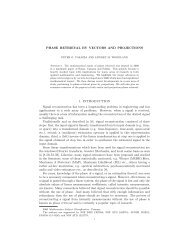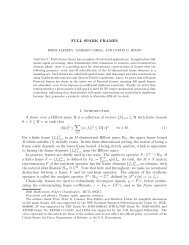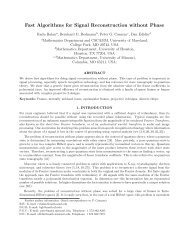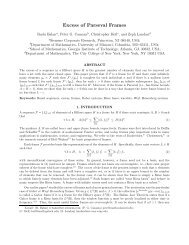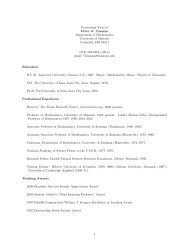Introduction to Finite Frame Theory - Frame Research Center
Introduction to Finite Frame Theory - Frame Research Center
Introduction to Finite Frame Theory - Frame Research Center
You also want an ePaper? Increase the reach of your titles
YUMPU automatically turns print PDFs into web optimized ePapers that Google loves.
<strong>Introduction</strong> <strong>to</strong> <strong>Finite</strong> <strong>Frame</strong> <strong>Theory</strong> 3<br />
As we will see, the generated sequence (〈x,ϕ i 〉) M i=1 belonging <strong>to</strong> l 2({1,...,M}) can<br />
then be used, for instance, for transmission of x. Also, careful choice of the representation<br />
system enables us <strong>to</strong> solve a variety of analysis tasks. As an example,<br />
under certain conditions the positions and orientations of edges of an image x are<br />
determined by those indices i ∈ {1,...,M} belonging <strong>to</strong> the largest coefficients in<br />
magnitude |〈x,ϕ i 〉|, i.e., by hard thresholding, in the case that (ϕ i ) M i=1 is a shearlet<br />
system (see [116]). Finally, the sequence (〈x,ϕ i 〉) M i=1 allows compression of x,<br />
which is in fact the heart of the new JPEG2000 compression standard when choosing<br />
(ϕ i ) M i=1 <strong>to</strong> be a wavelet system [141].<br />
An accompanying approach is the expansion of the data x by considering sequences<br />
(c i ) M i=1 satisfying x =<br />
M<br />
∑<br />
i=1<br />
c i ϕ i .<br />
It is well known that suitably chosen representation systems allow sparse sequences<br />
(c i ) M i=1 in the sense that ‖c‖ 0 = #{i : c i ≠ 0} is small. For example, certain wavelet<br />
systems typically sparsify natural images in this sense (see for example [78, 123,<br />
134] and the references therein). This observation is key <strong>to</strong> allowing the application<br />
of the abundance of existing sparsity methodologies such as Compressed Sensing<br />
[87] <strong>to</strong> x. In contrast <strong>to</strong> this viewpoint which assumes x as explicitly given, the<br />
approach of expanding the data is also highly beneficial in the case where x is only<br />
implicitly given, which is, for instance, the problem all PDE solvers face. Hence,<br />
using (ϕ i ) M i=1 as a generating system for the trial space, the PDE solvers task reduces<br />
<strong>to</strong> computing (c i ) M i=1 which is advantageous for deriving efficient solvers provided<br />
that – as before – a sparse sequence does exist (see, e.g., [107, 74]).<br />
1.2 Beyond Orthonormal Bases<br />
To choose the representation system (ϕ i ) N i=1<br />
<strong>to</strong> form an orthonormal basis for H<br />
N<br />
is the standard choice. However, the linear independence of such a system causes a<br />
variety of problems for the aforementioned applications.<br />
Starting with the decomposition viewpoint, using (〈x,ϕ i 〉) N i=1<br />
for transmission<br />
is far from being robust <strong>to</strong> erasures, since the erasure of only a single coefficient<br />
causes a true information loss. Also, for analysis tasks orthonormal bases are far<br />
from being advantageous, since they do not allow any flexibility in design, which is<br />
for instance needed for the design of directional representation systems. In fact, it is<br />
conceivable that no orthonormal basis with paralleling properties such as curvelets<br />
or shearlets does exist. A task benefitting from linear independence is compression,<br />
which naturally requires a minimal number of coefficients.<br />
Also, from an expansion point of view, the utilization of orthonormal bases is<br />
not advisable. A particular problem affecting sparsity methodologies as well as the<br />
utilization for PDE solvers is the uniqueness of the sequence (c i ) M i=1 . This nonflexibility<br />
prohibits the search for a sparse coefficient sequence.



